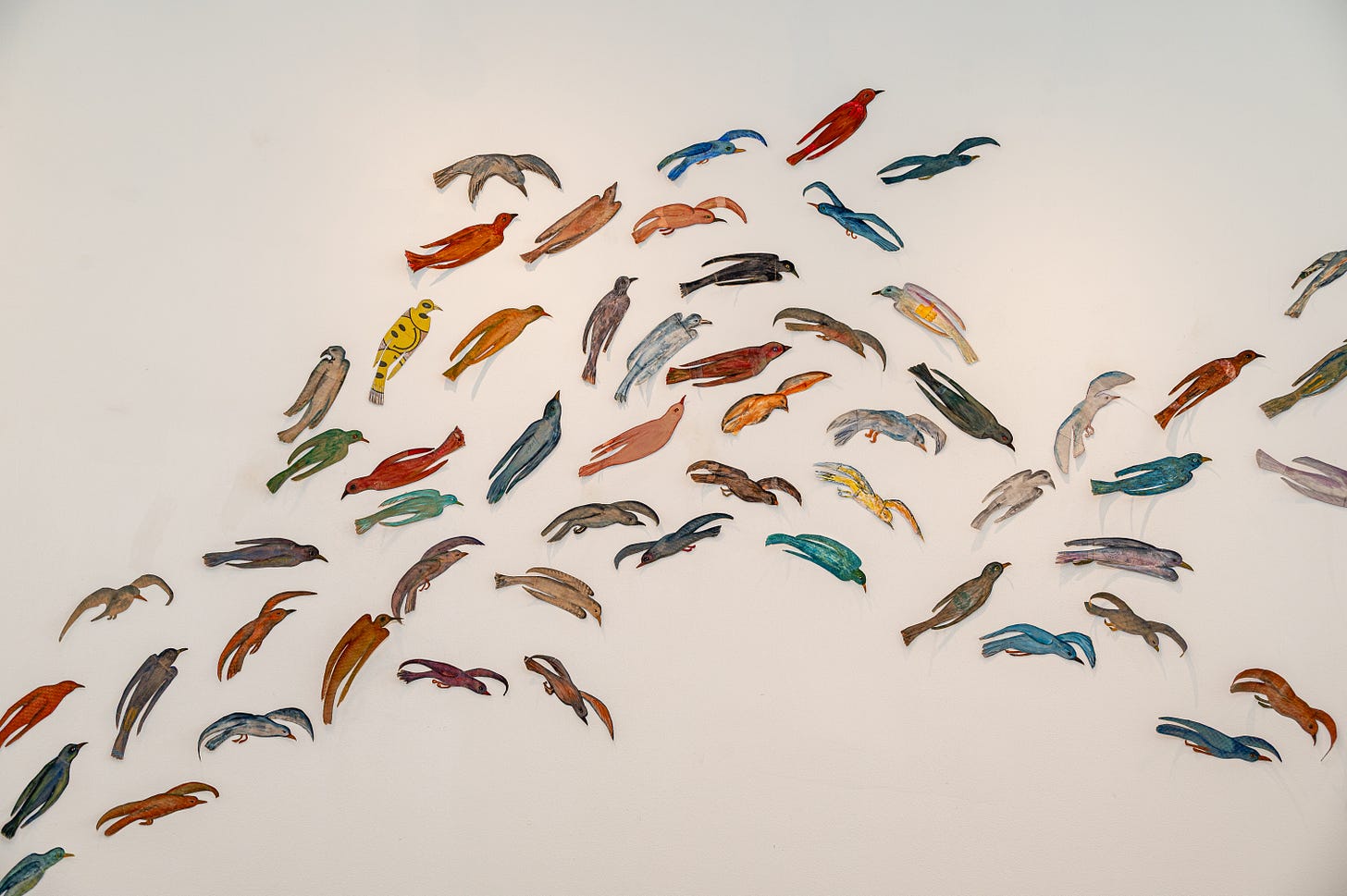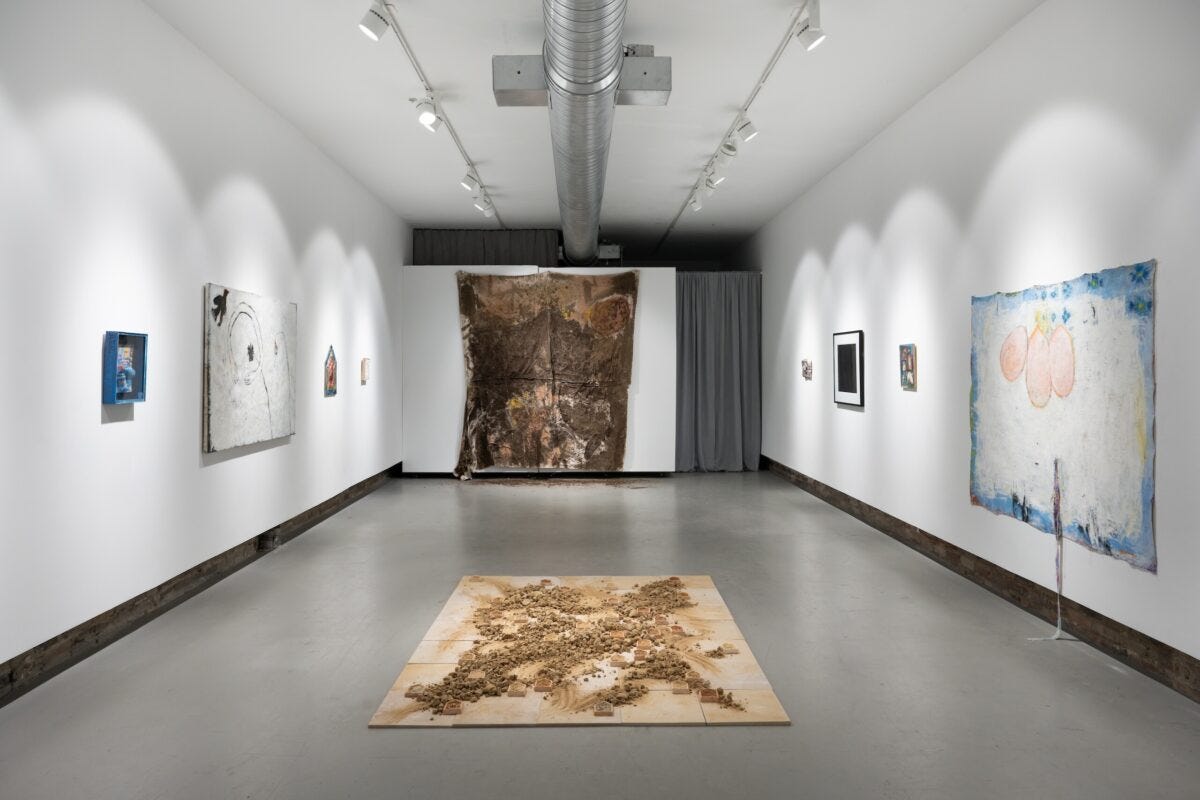Outside In
Alice Momm artfully gleans Glen Echo Park, and contributors to group shows at Studio Gallery and Hamiltonian Artworks glean rusted metal and dried clay
Alice Momm, “Flock” (Joe Bucherer)
NATURE IS THE THEME OF "GLEANER'S SONG FOR GLEN ECHO," but that doesn't mean all the ingredients of the mixed-media Popcorn Gallery show are natural. Alice Momm has covered a curving wall with painted silhouettes of birds, each one of the "Flock" cut from cardboard sleeves that once wrapped cups of carryout coffee. Another piece is a hive-like construction of dead vines from which living willow branches emerge, leafing green at their tops. The other ends are placed in glass light bulbs that have been filled with water and repurposed as minimalist vases.
Momm divides her time between New York City, where she composed a similar song about Central Park in 2020, and Washington. The latter is her childhood home, so she has treasured memories of Glen Echo Park. Her tribute to the former amusement park includes a small version of its carousel, albeit one whose animals are not megafauna but everyday indigenous mid-Atlantic creatures. The carousel is designed to be seen after sunset, when lights cast shadows that render the figures larger and yet less substantial.
The artist has a good idea what some of those native carousel species are, since one chapter of her project is a list of hundreds of beings that live in the park. The inventory-- "by no means complete," according to its title -- is presented in multi-color text on three narrow scrolls that stretch from ceiling to floor. Among the show's other words are Momm's poems, impressionistic and mostly inspired by birds; one explains how "Flock" was "conjured ... from guilt and waste."
Some pieces that appear to be merely foraged actually reveal a human touch: Dozens of dried individual leaves, neatly arranged on shelves, have been personalized with discreet stitchery. Elsewhere, what look to be natural objects are in fact simulated: Cross-sections of tree trunks are actually cardboard circles on which concentric rings have been painted in white. And Momm's reverence for nature is tempered by whimsy in such pieces as a rough basket, made of found sticks, from which three long-necked goose heads floppily protrude.
In a brief recent conversation, Momm noted that her method is about both "collecting and letting go." Her art, or at least its raw material, is "compostable." The ephemerality of the constituent parts, whether gleaned from a forest floor or a trash bin, highlights one advantage of nature over art. Both wither with time, but only nature spontaneously renews itself.
Joan Mayfield, “Splay” (Studio Gallery)
ASSEMBLAGES ASPIRE TO THE CHARACTER OF PAINTINGS in the work of four of the six contributors to "Lost and Found," a Studio Gallery group show curated by the Athenaeum's Veronica Szalus. The exhibition's statement invokes Marcel Duchamp, but these artists don't enshrine a single found object. Instead, they jumble and jangle multiple things.
Jennifer Duncan's mostly abstract collages are made of found and painted paper, often with drawn tree or leaf forms amid the dotted, dashed, and capillary-like patterns. Pam Frederick's photo-collages feature curling graffiti tags, cut and partly twisted; the artist also offers two 3D constructions made mostly of painted wood, although one centers on a steel painter's palette.
Doug Fuller clusters primarily metal pieces, often gnarled, sometimes flattened, and occasionally rusted. These found items are mounted on panels that are painted a single color, thus underlying the haphazard assemblages with pop-art tidiness. Such industrial metal artifacts as a spring, a crank, and an antique light switch are framed by worn wood in Joan Mayfield's constructions, whose methodical layouts are offset by the frayed materials. The artist plays with the idea of the picture frame, recessing objects into boxes. In "Splay," she projects three curved tubes -- browned metal pipes that look like tree branches -- from within a wooden rectangle painted a faded green. These battered components combine, improbably, to suggest vitality and even rebirth.
Bright color is the show's other motif, linking the 3D pieces to the work of photographer Bob Burgess and painter Al Lipton. The latter's gestural abstractions are mostly in prime colors, underscored by black, but it's yellow that breaks the picture plane. Thick gobs of that color, arranged in roughly parallel lines, both divide and unify the compositions.
Burgess's photos are the only works that are entirely flat and fully representational. Yet they're keyed more to color and shape than to narrative. A white doorknob protrudes from a red door that's bordered by a yellow wall, an arrangement that resembles an accidental flag. A red inflatable raft rests criss-cross atop a green one, which floats on mottled-blue pool water. Such meticulous compositions might denote the show's most minimalist entries, if only their hues weren't so voluptuous. In Burgess's pictures, color itself appears to splash beyond the surface.
Installation imnage of “New. Now. 25” (Hamiltonian Artworks)
MADE OF SUCH EARTHY MATERIALS AS MUD, PLASTER, AND DRIED CLAY, two large pieces by Nilou Kazemzadeh and Fargo Nissim Tbakhi set the tone for "New. Now. 25," a group show that introduces Hamiltonian Artists's five 2024-2026 fellows. With the notable exception of Jermaine "jET" Carter, the contributors offer art that is muted and minimalist, and often appears rough or damaged.
There's a sense of loss to much of this work, which speaks to the experiences of artists rooted in such fraught locales as Pakistan (Sobia Ahmad), Brazil (June Canedo de Souza), Iran (Kazemzadeh), the Palestinian territories (Tbakhi), and Black D.C. (Jermaine "jET" Carter). While all but Ahmad were born in the U.S., they have the perspectives of outsiders.
The process of decay is kinetic in Kazemzadeh's "A Mighty Tree Uprooted Becomes," a nine-minute video in which multiple fingers pull bits from soft 3D letters until the words become unreadable. One of Ahmad's photo-based works is a reproduction of a roll of exposed film whose images are -- or have become -- obscured. De Souza's paintings inscribe scratchy, loosely representational images into heavily worked white fields. In all these works, absence is as palpable as presence.
Like Kazemzadeh, Tbakhi transforms words into pictorial elements. In his map-like "Gazan Tunnel," red-lettered phrases snake through thickets of overlapping black text. Carter illustrates a different form of escape in "Man of the House," in which a boy stands, arms crossed, outside a modest rowhouse. While the other participants depict memories as frayed or faded, Carter's vision of youthful defiance remains sturdy.
Alice Momm: Gleaner's Song for Glen Echo
Through March 23 at Popcorn and Stone Tower Galleries, Glen Echo Park, 7300 MacArthur Blvd., Glen Echo. glenechopark.org/partnershipgalleries. 301-634-2222.
Lost and Found
Through March 22 at Studio Gallery, 2108 R St. NW. studiogallerydc.com. 202-232-8734
New. Now. 25
Through March 15 at Hamiltonian Artists, 1353 U St. NW. hamiltonianartists.org. 202-332-1116.





